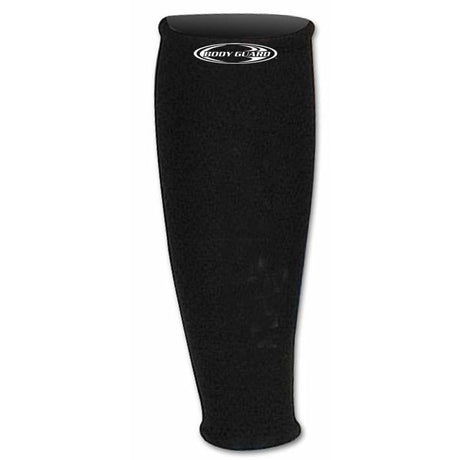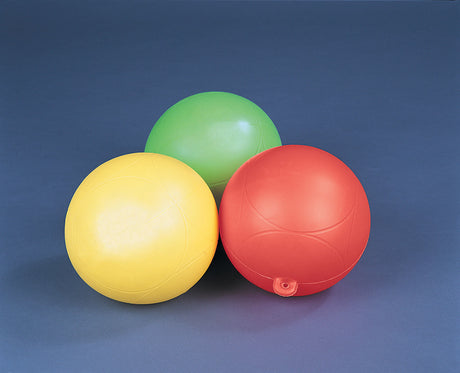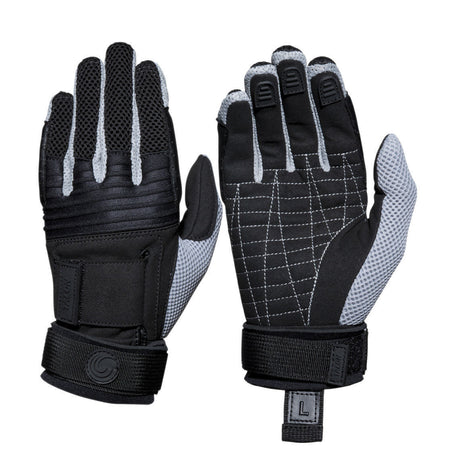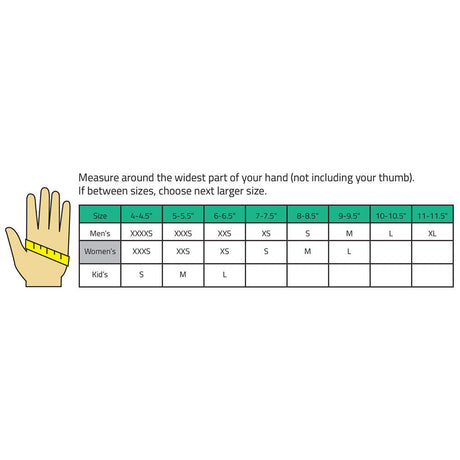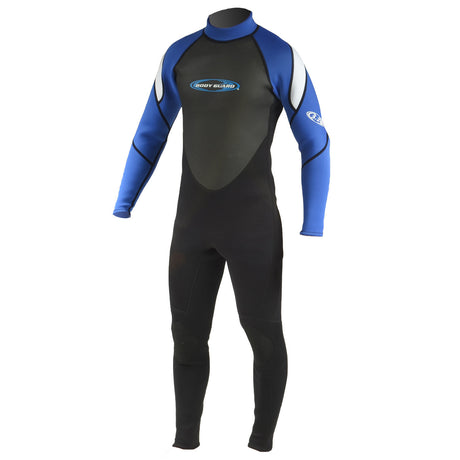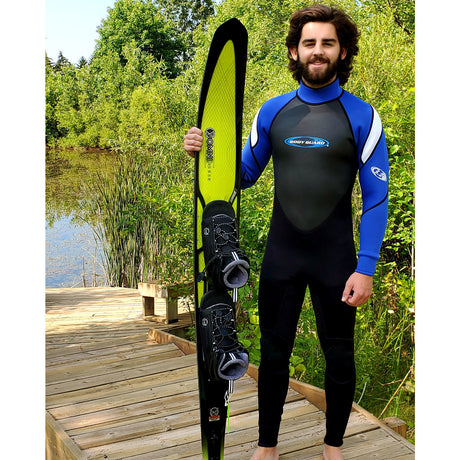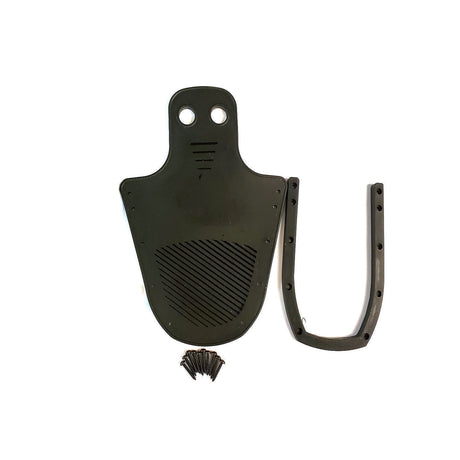Have you ever dreamed of effortlessly gliding across the water's surface, feeling like you're flying above the waves? If so, hydrofoil surfing might just be the ocean, lake or river water sport for you.
With foil surfboards, riders experience a unique feeling of floating or flying on top of the water that traditional surfboards just can't do. This is done by paddling, 'pumping' the board, using waves, electric-powered jets, or being towed.
In this beginner's guide, we'll explore everything you need to know to get started with hydrofoil surfing, from understanding what a hydrofoil surfboard is to mastering your first ride.
In this article:
Types of Hydrofoil Boards
What is a Hydrofoil Surfboard?
What is Electric Hydrofoil Surfing?
How Does Foil Surfing Work?
What Gear Do You Need?
How To Hydrofoil Surf
Tips for Successful Hydrofoil Surfing
What Comprises a Hydrofoil?
Which Mast Length is Ideal for Foil Surf Beginners?
How Much Will it Cost to Hydrofoil Surf?
Types of Hydrofoil Boards
Hydrofoil boards cater to a variety of water sports, including paddleboarding, wakeboarding, surfing, kiteboarding, and windsurfing.
These boards come in different styles, each tailored to specific riding preferences and skill levels.
Additionally, advancements in technology have led to the development of electric-powered hydrofoil surfboards, controlled via handheld remotes. These innovative boards offer customizable speeds and straightforward operation, appealing to avid water sports aficionados.
See our "Beginner's Guide to Wake Foiling".
What is a Hydrofoil Surfboard?
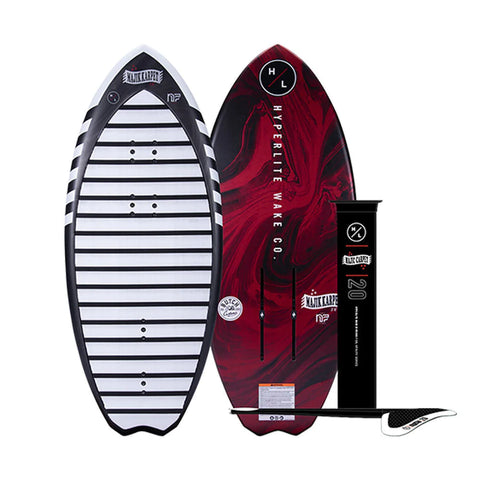
At its essence, hydrofoil surfing entails a board equipped with an elongated hydrofoil underneath. This hydrofoil, typically made of lightweight materials such as carbon fiber or aluminum, consists of a wing-like structure mounted below the board's surface. As the board gains speed, the hydrofoil generates lift, lifting the board out of the water and reducing drag, resulting in a smoother and faster ride.
Originating in 1999, courtesy of waterman Mango Carafino, hydrofoil surfboards have evolved into a commercial success, building upon earlier innovations in disciplines like water skiing and windsurfing.
What is Electric Hydrofoil Surfing?
Electric hydrofoil surfing, also known as e-foiling, takes hydrofoil surfing to the next level by adding an electric motor to the hydrofoil board. This motor provides propulsion, allowing riders to achieve higher speeds and cover greater distances with less effort. Electric hydrofoil surfing offers a thrilling and eco-friendly alternative to traditional water sports, combining the excitement of surfing with the convenience of electric power.
How Does Foil Surfing Work?
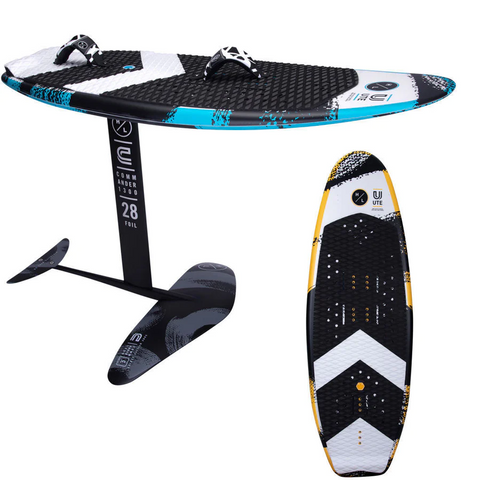
Generally speaking, hydrofoils deflect water flow downwards and result in an upward force being exerted on the craft (think of the wing of a plane lifting it up).
As the boat or craft accelerates, the hydrofoil eventually raises the hull of the boat or craft out of the water. The hydrofoil achieves a balance with the craft's weight at a certain point, causing it to no longer fully lift the boat or craft out of the water and ride perfectly above the water.
Hydrofoil surfboards now incorporate hydrofoil technology for improved performance. These boards maintain the board design, but they have a metal or carbon fiber hydrofoil attached to the bottom of the board. The hydrofoil extends a few feet from the board and features a small airplane-like structure at its tip. In the exact same way, it deflects the flow of water downward and reduces the water's impact on the board, resulting in a smoother and faster ride.
With foil boards, riders experience a unique feeling of floating or flying on top of the water that traditional surfboards just can't do. This is done by paddling, 'pumping' the board, using waves, electric-powered jets, or being towed.
This means foil surfboards have the advantage of enabling riders to stand up on the board without specifically requiring a wave to start. This ability means they can be used on inland lakes and rivers without waves.
What Gear Do You Need?
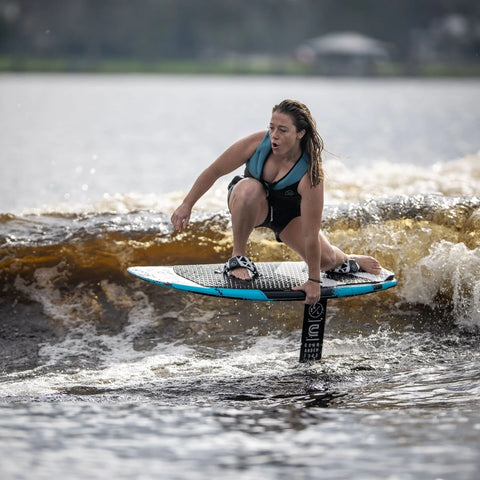
To embark on your hydrofoil surfing adventure, you'll require essential gear, including a hydrofoil board, wetsuit, surfboard wax, life jacket, and a leash for safety.
Additionally, protective equipment such as a helmet and impact vest is advisable, particularly for beginners. If initiating without waves, a tow vehicle or means of generating speed—such as a boat or jet ski—is essential, as hydrofoil surfing demands greater velocity than conventional surfing.
How To Hydrofoil Surf
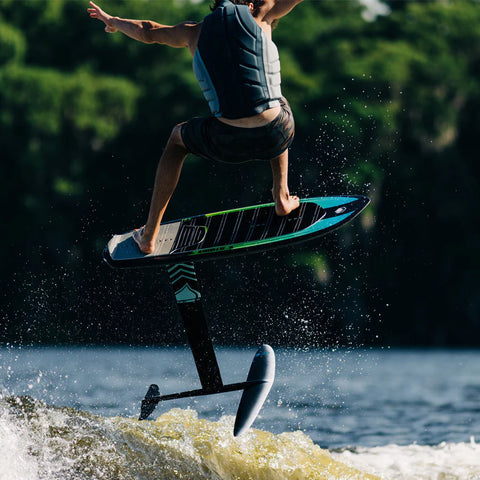
Can I Foil Surf on an Inland Lake or a River?
Yes! A rewarding foil surf excursion to destinations like Maui or Southern California hinges on Mother Nature's whims to deliver consistent waves. However, with a wake boat and foil surfboard, wave assurance is guaranteed, allowing you to simply relax and savor the ride.
In fact, some say it’s easier to learn the basics of surf foiling while being towed behind a boat in order to understand how the foil lifts and turns.
Step 1: Hydrofoil Dock Start with a Hydrofoil Surfboard
Before you hit the waves, it's essential to learn how to start with a hydrofoil surfboard from a dock. Begin by positioning yourself on the dock with your feet shoulder-width apart and the hydrofoil board in the water beside you. Grip the board's rails firmly and push off the dock, allowing the board to glide smoothly across the water's surface. Once you've gained enough speed, shift your weight slightly forward to engage the hydrofoil and lift the board out of the water.
Once you’ve got the hang of starting from a dock, it is time to move to step 2.
Step 2: How to Hydro Surf While Being Towed on a Foil Surfboard
Ensure Board Alignment: Ensure that the board is perpendicular to the direction of the rope before starting. Have the boat driver engage the boat in gear or move forward slowly to create pressure for placing your feet on the foil.
Signal Acceleration: Signal the driver to gradually accelerate, maintaining a speed of 9-12mph. Speed adjustments may be necessary based on factors such as board type, rider preference, and foil specifications.
Locate the Optimal Position: Maintain front foot pressure to avoid premature foil engagement. Hold onto the rope with both hands to enhance forward pressure. Align your hips and shoulders squarely on the board, while bending your knees for stability.
Master Flight Technique: Shift your weight backward and apply pressure to your back foot to initiate lift-off. Keep your movements subtle and controlled to maintain stability and control.
Monitor Foil Size: Be mindful of the foil's size to prevent breaching. Breaching occurs when the foil makes gurgling noises and you begin to lose balance and fall forward.
Build Confidence: Practice maneuvering, turning, and adjusting your position on the foil while avoiding breaching. Consider transitioning to a longer mast for enhanced stability and control.
Can I Foil Surf in an Ocean?
Yes! It’s all about small waves, or surging water. In fact, it is easiest to learn by tapping into the energy of a wave that with a regular surfboard isn’t “rideable”.
Get a Hydrofoil Surfboard in Motion on a Wave in the Ocean
Getting a hydrofoil board in motion requires a combination of paddling and pumping techniques.
To start, paddle into a wave using the same techniques you would with a traditional surfboard, using your arms to generate momentum and propel the board forward. When you notice an approaching wave, begin paddling until you sense that you've caught it.
The initial process of catching a wave on a foil surfboard mirrors traditional surfing. Upon standing up, exert pressure on your front foot, akin to maneuvering while snowboarding downhill. As the wave steepens, lean forward progressively to maintain balance and control. Harness the wave's energy to gain speed and lift the hydrofoil out of the water.
During your initial rides, you'll encounter a distinct sensation compared to conventional surfing. To sustain balance and prevent falls, assume a squat stance with an upright chest and open shoulders.
The further you lean back onto your rear foot, the greater the wing's inclination upwards, resulting in increased lift. Conversely, shifting weight onto your front foot causes the wing to submerge further underwater.
Tips for Successful Hydrofoil Surfing
- Maintain Proper Direction: Always ensure the hydrofoil fin is facing forward to facilitate forward movement.
- Maintain a low center of gravity: Keep your knees bent and your weight centered over the board to maintain stability and control.
- Use Your Hips for Steering: Shift your upper body and hips to steer the board effectively. Point your hips in the desired direction and pump your knees while adjusting your upper body. Wide arm positioning aids in sharper turns.
- Focus on Balance: Keep your knees slightly bent and distribute your weight evenly across the board, avoiding excessive leaning forward, which may hinder speed.
- Pump for Momentum: In the absence of external forces such as waves or wind, utilize your forward-facing foot to pump the board, maintaining momentum and speed.
- Exercise Caution: Remain vigilant of other watercraft, swimmers, and obstacles, steering clear of shallow waters and potential hazards.Start slow: Begin with small, gentle waves and gradually work your way up to larger swells as you gain confidence and experience.
- Practice patience: Hydrofoil surfing requires patience and perseverance, so don't get discouraged if you don't master it right away. Keep practicing, and you'll improve over time.
What Comprises a Hydrofoil?
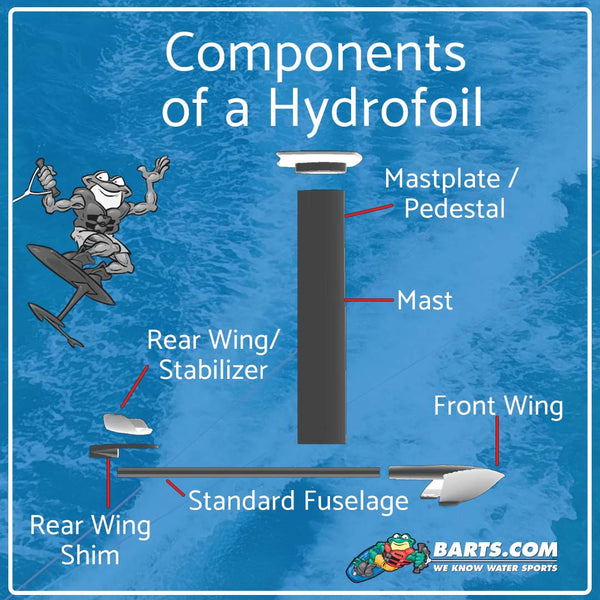
Foil Wings:
This component is the heart of the setup, responsible for generating lift, making it pivotal when considering a hydrofoil purchase. The length, shape, and material of the foil wing significantly influence overall performance.
When selecting a front wing, factor in your desired foiling experience in terms of stability and speed. Larger wings offer enhanced stability, enabling easier recovery from errors without compromising ride quality or lift. They are well-suited for beginners and those seeking forgiving foiling encounters. Conversely, smaller wings provide increased agility for carving and pumping but may pose challenges for novice riders. Moreover, wing efficiency dictates speed, often categorized as follows:
- High Aspect: Facilitates high speed
- Medium Aspect: Offers moderate speed
High Aspect Wings boast lower drag, enabling swifter speeds. Similarly, smaller wings contribute to velocity due to their reduced drag, while larger area wings cater to slower rides, accommodating heavier riders and offering greater stability for beginners.
Similar to the front wing, the size of your back wing influences stability, agility, and speed. Smaller back wings minimize drag, facilitating faster turns and speeds, whereas larger back wings enhance wave stability.
The Foil Board:
While in other board sports, the board typically serves as the primary connection between the rider and the surface (be it water, snow, or concrete), in foiling, the emphasis shifts slightly. Here, the foil wing takes on a significant role in lifting the rider (pun intended), making the board's shape, construction, and style somewhat less crucial.
Nevertheless, it's still essential to select a board that aligns with your desired performance, which boils down to factors like construction and size.
For newcomers to the sport, we recommend starting with a compression-molded or foam-coated board. These options tend to be heavier and absorb more vibrations, offering stability beneficial during the initial learning phase.
For those aiming to advance quickly and integrate foiling extensively into their water endeavors, fiberglass or carbon construction boards are preferable for their performance-oriented attributes. Advanced boards, particularly those crafted from carbon fiber and boasting surf-style construction, are lighter and deliver a more precise feel on the water.
When considering size, akin to wakesurfing, smaller boards typically demand a higher level of skill but facilitate quicker turns and enhanced maneuverability. Conversely, larger boards feature a broader planing surface, ensuring easier control and providing a smoother ride for beginners. During the learning process, frequent touches on the water's surface are common. Opting for a larger board aids in swift recovery onto the foil. However, smaller boards, while lacking the same rebound effect, offer a thrilling ride once proficiency is attained, enabling confident cruising above the water.
The Foil Mast:
The performance of your ride is influenced by the length of the mast. Serving as the link between your board and the foil wings, the mast's size plays a crucial role. The mast refers to the metal component between the board and the foil.
Elevation Above the Water: A longer mast elevates you higher above the water, granting increased maneuvering space.
Efficiency in Pumping: A taller mast enhances pumping efficiency, empowering riders to sustain or boost speed even in lighter wind conditions.
Navigating Choppy Waters and Waves: Longer masts offer better tolerance in choppy waters and waves by providing greater clearance above the water's surface.
Most foil surfing masts range from 24" to 28" (60cm to 72cm). However, some brands offer masts as short as 14" and as long as 32", providing extensive customization options tailored to individual rider preferences and needs.
Which Mast Length is Ideal for Foil Surf Beginners?
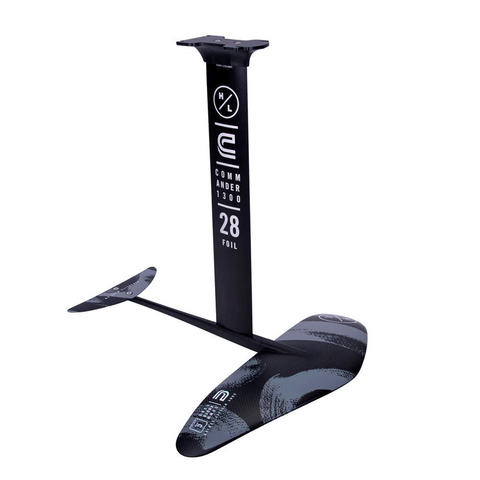
Beginner masts tend to be shorter, optimized for slower speeds, while larger mast sizes cater to advanced riders seeking higher speeds or tackling larger waves.
A larger mast size enhances stability, particularly in choppy water conditions, allowing riders to maintain their position on the foil without touching the board to the water's surface.
Begin with a shorter mast. Shorter masts offer greater control, enhance safety during the learning process, and significantly accelerate progression beyond initial challenges.
Conversely, for tow-in foiling or navigating larger waves, opting for a longer mast facilitates increased speed and expands vertical maneuverability.
How Much Will it Cost to Hydrofoil Surf?
The cost of hydrofoil surfing can vary depending on factors such as the quality of equipment, location, and any additional expenses such as lessons or rentals. Generally, you can expect to invest anywhere from a few hundred to several thousand dollars in equipment, with ongoing costs for maintenance, repairs, and accessories.
Now that we've outlined the fundamentals of surf foiling, let's recap the essential points:
Hydrofoil surfing offers a unique and exhilarating way to experience the ocean, lake or river like never before. Whether you're a seasoned surfer looking for a new challenge or a beginner eager to learn, hydrofoil surfing has something to offer everyone.
- Foiling is adaptable to various boat types and water conditions.
- Opt for a smaller mast and larger board during the initial learning phase of foiling.
- Select a board construction, wingspan, and mast size that align with your skill level and proficiency.
So grab your foil surfboard and get ready to take your surfing skills to new heights with hydrofoil surfing.



